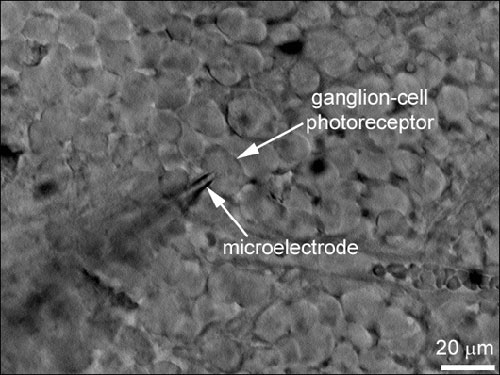Administrative Contact
Brynn Farnstrom: 734-232-8213
Areas of Interest
Research Summary
Physiology of intrinsically photosensitive retinal ganglion cells (“ipRGCs”), which regulate non-image-forming visual responses including the pupillary light reflex and circadian photoentrainment
Vision is our most important sense, enabling us to discern the identity and movement of objects in our surroundings. In addition to such “image-forming” functions, our visual system supports a variety of “non-image-forming” responses to environmental light. Examples of these largely subconscious visual responses include constriction of the pupil, synchronization of daily physiological rhythms to the light/dark cycle (i.e. circadian photoentrainment), acute enhancement of alertness, regulation of hormone secretion, and rudimentary light recognition in some blind patients.
Both types of visual processing begin in the retina. One of the most surprising recent discoveries in neuroscience is that, unlike image-forming vision, non-image-forming vision does not require rod or cone photoreceptors. This is because non-image-forming photoreception is mediated not only by rods and cones, but also by the intrinsically photosensitive retinal ganglion cells (ipRGCs), a rare type of ganglion cell that expresses the light-sensing molecule melanopsin and functions as a photoreceptor. Dr. Wong’s laboratory is using electrophysiology, multiphoton microscopy, immunohistochemistry, and behavioral assays to answer the following questions:
- How do ipRGCs respond to different kinds of light? What stimuli optimally activate ipRGCs and non-image-forming visual responses?
- How do ipRGCs interact with other neurons in the retina?
- Five types of ipRGCs have been discovered in mice. What are their functional roles?
The long-term goal of Dr. Wong’s research is to generate data that may guide the invention of:
- Drugs and light therapies for treating jet lag, sleep disorders, and depression
- Daytime lighting technologies that maximize alertness and hence productivity at work and school
- Nighttime lights that minimize the harmful effects of nocturnal light exposure while supporting image-forming visual tasks such as reading
- Pharmacologic agents and electronic devices that enhance the visual capabilities of people who are blind

Whole-cell patch-clamp recording from an ipRGC in a flat-mounted rat retina

The melanopsin-mediated photoresponse of a rat ipRGC

The morphology of a rat ipRGC revealed by intracellular dye fill.
Green: Lucifer Yellow injected into this ipRGC
Blue: TO-PRO-3 staining of the nuclei of all neurons in the ganglion cell layer
Credentials
- PhD - Biology, Harvard University
- Postdoctoral - Neuroscience, Brown University

